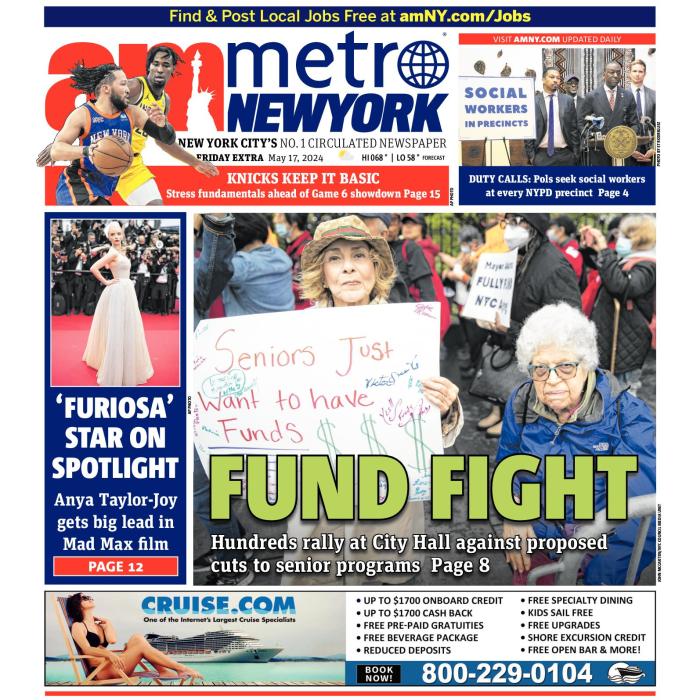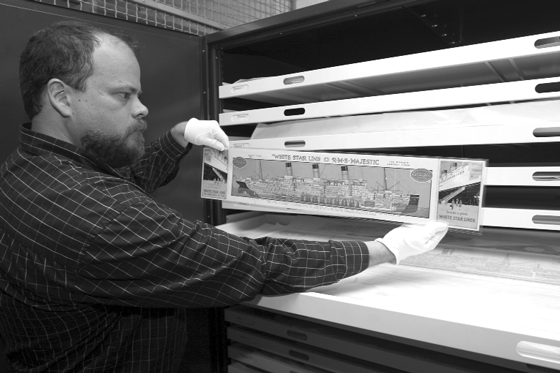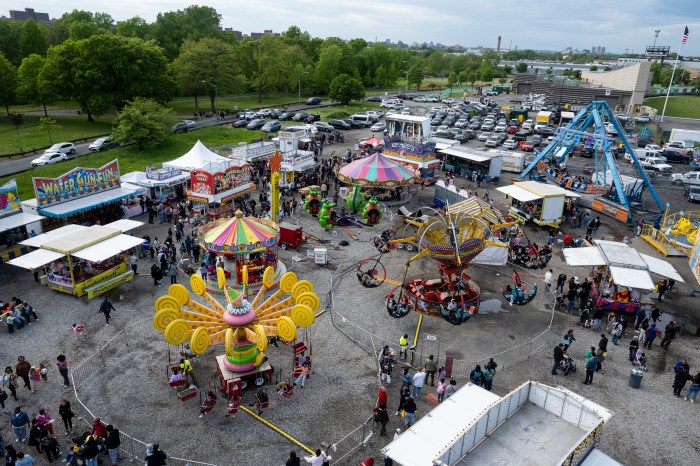By Anindita Dasgupta
Jeff Remling, South Street Seaport Museum curator, with a detailed drawing of the R.M.S. Majestic, one of thousands of pieces recently donated to the museum.
Even though the Titanic never completed her maiden voyage from England to Lower Manhattan, pieces from her trip and other ocean liners have finally settled Downtown at the South Street Seaport Museum.
The museum recently announced three additions to their collection, making it one of the biggest resources for ocean liner memorabilia, said Der Scutt and chairperson of the museum’s ocean liner council.
Known for his own extensive collection of ocean liner memorabilia, Scutt has been collecting since 1989. “Some people do drugs, I do ship models,” said Scutt, the architect who designed Trump Tower and redesigned 40 Wall St. for Donald Trump. “The disease is unexplainable.”
The new collections, the Theresa B. Stuchiner Collection, Marilynn Klein Collection, and Stanley Lehrer Collection, will be used in exhibits and made available to scholars for research purposes, museum officials said.
“The museum’s collection is its strength,” said Jeff Remling, museum curator of collections. “The greater a museums’ collection, in both quantity and quality, means the greater range and depth of the exhibitions the institution will be able to display.”
“It took a long time,” Scutt said of securing the collections in a phone interview last week. “As the founder of the Ocean Liner Council one of my goals is to make the museum the world’s largest center for ocean liner study.”
Scutt worked with the families donating the collections, assuring them their donations would be kept safe by the museum’s elaborate dehumidification and security system.
After her husband passed away, Theresa B. Stuchiner searched for a place to donate his collection of 1,248 cast pewter and plastic miniature scale models of ocean liners and U.S. Navy warships. The models, which came to the museum last fall, were mostly constructed in the last 20 years, and represent ocean liners like the Queen Elizabeth II, Titanic, United States and Normandie.
Similarly, in July, Theresa Klein donated her late husband Fred’s collection of ship, engine room, and bridge gauges, dials and telegraphs with some of its earliest pieces from 1898 and others dating back to the 1920s and 1930s. According Remling, prior to the Klein collection, the museum only had seven or eight gauges. The Klein collection, which includes 12 pieces, will help the museum illustrate ship mechanization and explain how large ships operate. During the “golden age” of ocean liners (between the end of the 19th century and World War II), passenger lines competed to produce not only the most comfortable, but also the fastest and safest ships. As a result ocean liner mavens interested in this great race may take special interest in the Klein collection.
While the Stuchiner and Klein collections have been catalogued already, the Lehrer collection, which was donated in June, is expected to take six to nine months to catalogue. The museum estimates the collection contains over 2,500 items and eventually, plans to add pieces from the collection to some of the museum’s ongoing exhibits.
It was donated by Stanley Lehrer, founder, former publisher and editorial director of USA Today. Lehrer is noted for his collections of rare Titanic artifacts, which have been displayed all over the U.S., Canada and England. Scutt worked closely with Lehrer for months to obtain his Collection of General Ocean Liner Memorabilia for the museum. Scutt said Lehrer acquired many items that have never appeared on the market with a dealer during that period.
The collection includes autographs of famous personalities who traveled on the ocean liners, letters and postcards from passengers, logs of voyages, passenger lists, deck plans, menus, posters, reference books, sailing announcements and more. After going through the collection, Scutt called it “absolutely exquisite,” roughly placing the market value for the entire collection at well over a million dollars.
Scutt donated a large part of his own ocean liner collection in 2001. The Der Scutt Ocean Liner Collection holds as one of the museum’s largest donations, said Remling, accounting for the majority of the museum’s ocean liner collection. Between Scutt’s collection, a few smaller collections acquired in the last five years and the three new collections, Scutt said the museum’s collection is highly competitive now.
Ocean liner memorabilia aficionados like Scutt and Lehrer are not alone in their love of the vessels. They are part of a people who admire all things ocean liner, treasuring each morsel of trivia they come across. Unable to suppress their devotion, they find themselves offering tidbits like which ocean liners served the best food (the French liners, evidenced by the line of seagulls trailing after the ships, said Scutt) to anyone showing interest.
The “disease” as Scutt calls it, doesn’t come cheap. Those infected study and collect everything from the menus served on ships (some of which sell for $50,000 to $70,000 each), to cutaways showing detailed interiors of ships (which sell from $500 to $700 apiece at auctions). Remling said that collectors often find pieces at auctions and flea markets. Items can also be found online through dealers, where prices appear to vary greatly.
“We have a growing constituency,” Scutt said. “The interest is growing in leaps and bounds with the [museum’s] acquisitions.”
















